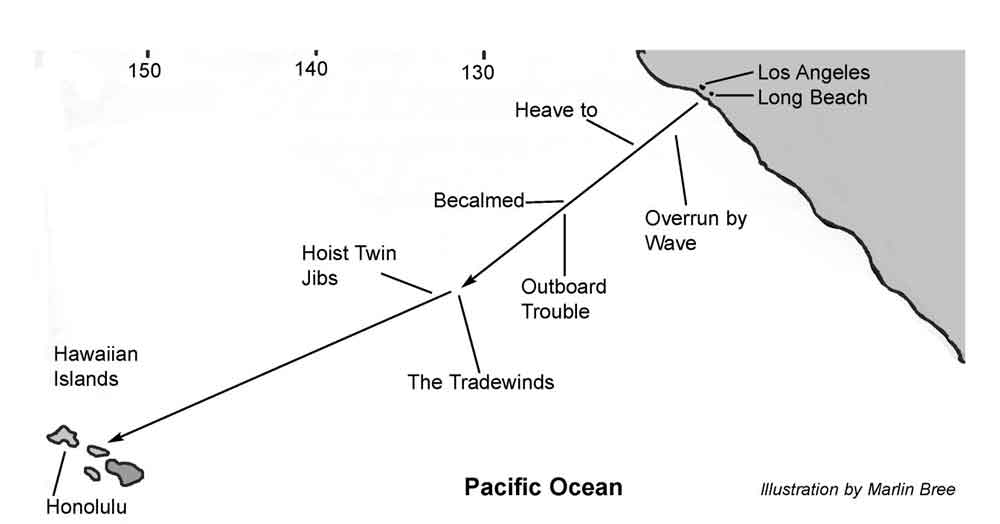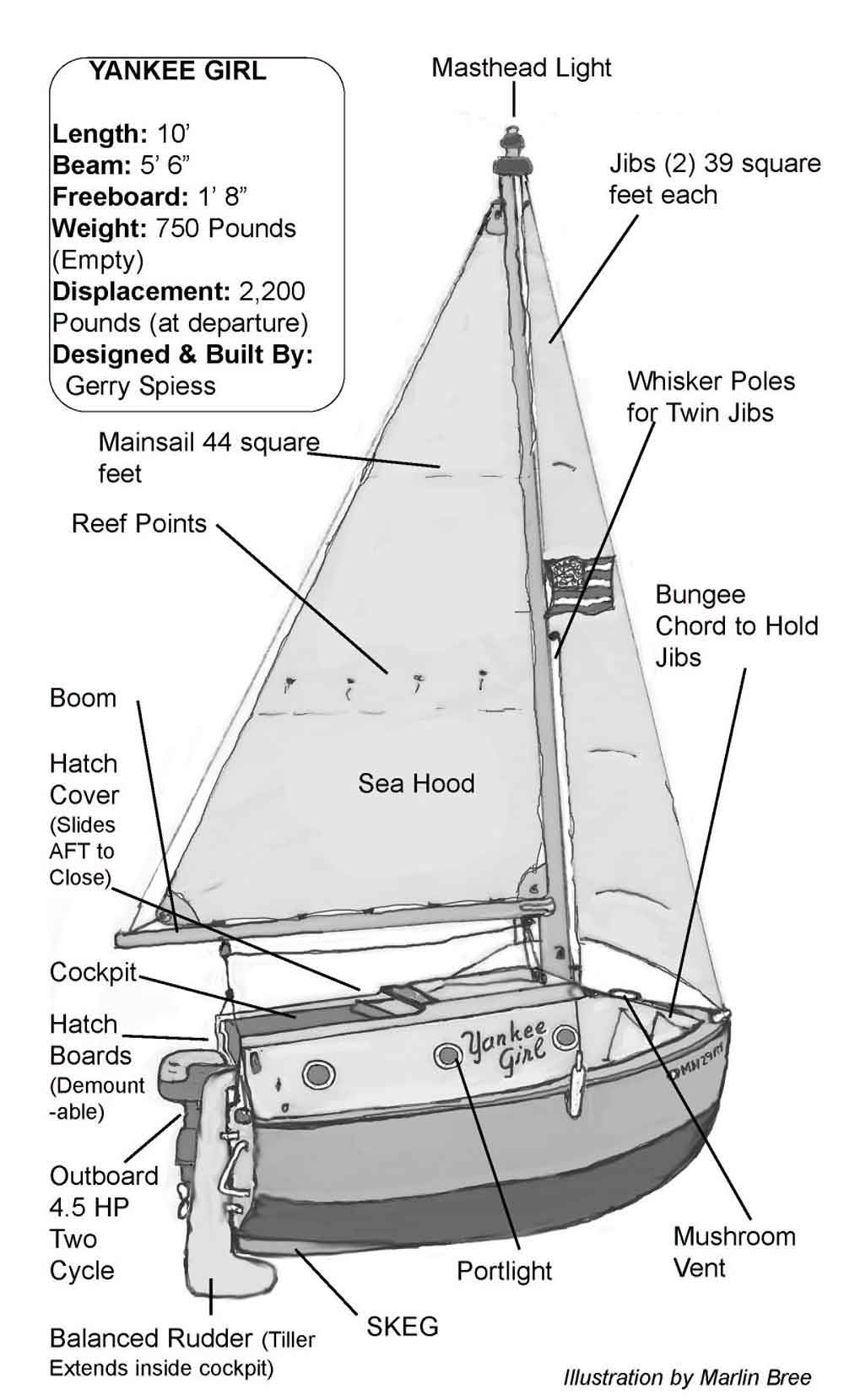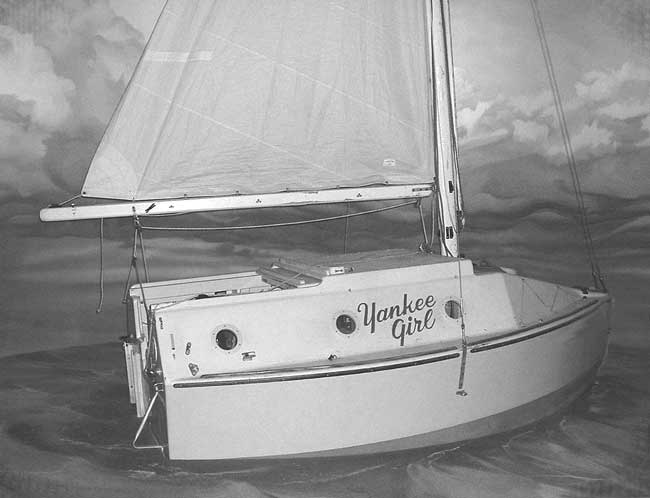TEN FEET ACROSS THE PACIFIC
Gerry Spiess heads Yankee Girl toward Hawaii
EPISODE TWO:
Gerry Spiess heads Yankee Girl
toward Hawaii
 |
| By Marlin Bree Copyright 2005 From Broken Seas |
PROLOGUE
In his 10-foot plywood boat, Yankee Girl, Gerry had shoved off from Long Beach,
California, hoping to quickly pick up the South Pacific's steady and balmy trade
winds. His first port of call, Honolulu, Hawaii, beckoned to the west. But the
White Bear Lake, MN, sailor encountered problems with storms and a balky
outboard.
* * *
He did not feel the first, gentle gust, but his engine speeded up from its usual
fast idle.
Odd, Gerry thought, and, he looked up to see his sails starting to draw.
His boat was a wind ship again.
It was the beginning of the third stage of his trip to Hawaii, and, the one he
looked forward to the most. He shut down the little outboard by choking it off
and let the trade winds carry him to the islands.
Soaring along in the trades was a wonderful feeling, and, Yankee Girl was
clearly enjoying herself, bowling along majestically on a peaceful, rolling sea.
The Pacific was starting to live up to its legends.
In crossing the North Atlantic, he came to rely on his twin jibs to pull him
along, but now he could try out his 180-square-foot spinnaker, set on two poles.
The big red chute ballooned up in front of him, and, Yankee Girl picked up
speed.
But it was not a comfortable ride with all that canvas up. Yankee Girl seemed
not to handle or steer well; she would yaw a bit and need course correction.
Frankly, she worried him.
After several hours, Gerry hauled it back down and again hoisted his twin jibs.
In this arrangement his two 39-square foot jibs were both poled out from the bow
to resemble two odd-shaped triangles. By sheeting each jib separately, he could
control the sails perfectly from the safety of his cockpit.
* * *
Yankee Girl steered herself in the trade winds without his hand on the helm and
with perfect control. He noted with satisfaction that his speed was only a
two-tenths of a knot slower than with the spinnaker.
Now in her element, the little boat began to eat up the miles. With the twin
jibs pulling her along like small ponies, her daily run increased. Some days,
she'd do 85 nautical miles - some days, 95.
Gerry relaxed in the open cockpit, enjoying his fine pocket cruiser in the trade
winds and bright sunshine. This was the South Pacific he had hoped for.
As he peered into the water, he saw that its color had changed to a deep indigo
blue. He reached over and cupped a handful just to admire its beauty.
For his navigation, he had two Davis plastic sextants. This included a sextant
he bought for $20 and had used to cross the Atlantic. He mostly used the $20 one
because he liked it so much.
From his navigational calculations, he knew he was nearing the Hawaiian Islands,
so he turned on his transistor radio and listened to a broadcast from a Hawaiian
station. He had an aircraft radio on board, and, he could hear pilots somewhere
in the skies checking with air controllers in preparation for landing.
As one flight high in the sky came nearly overhead, Gerry called to it via his
aircraft radio. He told them where he was and gave them his GPS coordinates, but
after several tries, the pilots could not make him out in the waves below. Gerry
watched their contrails etch white against the blue sky.
The jet would land in Honolulu in 40 minutes. He'd be there in about five days.
* * *
Off in the distance, the islands of Hawaii rose to greet him, first the Big
Island, then, Maui, and, finally Molokai. Blue peaks emerged out of a light
hazing of mist, and, he could see their green tips from a long way off.
 |
It was his first sighted landfall in nearly 2,500 miles, and, the islands were
right where his plastic sextant told him they'd be. Gratefully, Gerry steered
around the northern edge of Molokai to a small beach, with a sand bottom, and
good protection from the trade winds.
It was late afternoon when he dropped his small anchor and began to make
preparations for his landing at Honolulu. He did not want to come through the
Kaiwi Channel at night on his way to Oahu, and, he needed to make preparations
after many days at sea.
With Yankee Girl bobbing in the blue waters, and, Molokai's green hills nearby,
Gerry enjoyed the Hawaiian breezes with the hatch open. The land smelled
wonderful, but there was much to do.
From the bow area, he brought up some empty gas cans, which he filled with
seawater, so that he'd have the right trim. Since Yankee Girl did not have any
permanent ballast, but relied upon stores for weight below, maintaining the
right load in the bilges was critical.
He checked his main gas tank, and, figured he'd have enough gas left to make it
in to Honolulu. No need to top it up: he'd sail in the beautiful trade winds and
he'd need to run his engine only for maneuvering.
He shook his head: there was a lot of housekeeping to do, but that'd have to
wait. Down below in the bilges, salt water had begun to rust some of his cans of
food and supplies. The inside of his boat was damp, because of the water he had
taken inside through the hatch closures.
He had already lost his flannel-lined sleeping bag, which had gotten soaked. He
had tried to dry it out, but on a small boat, there was no room, and, after
three days, it began to smell badly - like old tennis shoes. His only recourse
was to toss it overboard. For warmth, he had huddled under several blankets,
because the early part of the voyage had temperatures lower than expected in the
cold California current, which swept a third of the way to Hawaii
But now tropical breezes wafted over him. He had a supper out of a can - his
favorite at sea, Dinty Moore stew - and, fell asleep, exhausted. It was a good
night's sleep, in the shadow of the great island, bobbing gently in protected
blue waters.
Tomorrow would be his homecoming.
* * *
The VHF radio inside the grass-thatched bar in Honolulu had been squawking
transmissions as I listened to Gerry's messages.
 |
Gerry's destination was the Waikiki Yacht Club. I had flown over with my wife,
Loris, and my son, Will, to greet him.
Some members of the media had been out in the channel in chartered boats to film
Yankee Girl's triumphant arrival and were back, looking somewhat green.
"God that was rough," one of them said. "What must it have been like in that
little boat?"
It had been a wild ride, no question of it. The Kaiwi Channel lies between the
islands of Molokai and Oahu and funnels both trade winds and currents into
fast-moving, high waves. Even many local sailors don't venture out into the
rough Kaiwi Channel.
But it was a sleigh ride for Gerry heading past Diamond Head. Speeding along on
only one jib, he sat on the starboard side of the cockpit, bracing himself in
the rollers, and waving to members of the press.
He was jubilant. He and his boat were headed home.
* * *
In the Waikiki Yacht Club bar, I kept hearing Gerry's voice on the VHF radio.
Yankee Girl had arrived outside the breakwaters, and, he seemed impatient to
come in.
I knew why. He was waiting for someone to guide him into the harbor, and, that
someone was sitting at a table in front of me.
"I need to finish this hand," I was told. The skipper was playing cards.
As I was to learn, these were the islands, and, some things were done on island
time.
Minutes later, the card game ended, and, our skipper swallowed the last of his
gin and tonic. "Let's go," he said with a grin, and we walked along the Ali Wai
small boat harbor quay to his trawler.
The diesel fired up, and, the trawler headed out majestically. It was not hard
to figure out where Yankee Girl was-a small squadron of boats surrounded her.
Gerry was standing in the cockpit, rolling back and forth in their wake.
From the trawler's bridge, I called down to Gerry and then waved. Gerry seemed
to squint, but did not recognize me. I tried the radio, but got no response.
I shouted, "Follow us."
Yankee Girl snicked into gear. Gerry began following the trawler into the
harbor, escorted by some of the inquisitive boats in a sort of informal parade.
Gerry had been given the guest of honor berth at the club - right in front of
the open-air restaurant. The word had spread around the island, and, people had
gathered to see the remarkable little boat and its builder-skipper.
After his long sea voyage, Gerry had to be helped from the boat, and, as he
walked I saw that he was supported on both sides by his wife, Sally, and, his
dad, Lou.
"Marlin," Gerry said, after staring at me. "You made it."
He looked around: "Where's Will?" He had always been fond of my young son.
"He's here," I said, pointing. Walking in Gerry's footsteps was our 11-year-old
son, ever so carefully staying out of his way, but never far, either.
"Hey!" Gerry said, delighted.
In the hours ahead, Gerry began to get his land legs back and I marveled at how
well he looked - sun tanned and healthy, with a dark beard. Despite being in his
boat all this time, he had seemed to achieve a small sartorial miracle: he
appeared nattily dressed in clean, pressed clothing, just as if he had just
stepped from one of the beautiful Honolulu hotels.
Once again, it was Gerry's knack for detail that was paying off: he had packed a
plastic canister with clean, fresh clothes just for this occasion, and, had put
them on this morning.
I was impressed. It was a small, but significant detail, and, only one in a
chain of events and details he had carefully thought through. All of his
preparations had paid off on this voyage. He had just crossed the biggest single
leg of his journey across the world's biggest ocean, and, he had set a record
for doing so in the smallest boat ever.
Moreover, his little boat had handled beautifully, both in storms and in the
trade winds. He had averaged 65 nautical miles per day (74.75 statute miles),
outstanding for any boat much less one only 10 feet long, and, had reached 95
nautical miles (109.25) in his best day's run. He had estimated that it would
take him 36 days to make his crossing. He did it in 34.
Nothing had broken on the "little girl," as he came to refer to her, and, she
had done everything he had asked of her.
Yankee Girl had once again proven herself.
There was no question in Gerry's mind that she easily could carry him the rest
of the way across the wide Pacific.
* * *
Analyzing Yankee Girl:
A remarkable ten-foot boat
Gerry Spiess had not only built Yankee Girl, but had designed her. He once told
me he considered the six-year design challenge to be the most interesting part
of the entire project. A former school teacher in the White Bear, Minnesota,
school system, he became fascinated with micro-boat voyages and the intellectual
process of creating, designing and building the smallest boat ever that could
safely cross any ocean - unaided and entirely on her own.
She had to carry everything she needed for both herself and her sailor, and,
that included huge amounts of gear and provisions. Yankee Girl was a monumental
boat on a 9-foot 9-inch waterline. As a bare hull, she weighted less than 440
pounds. With her running gear, she weighed 750 pounds; and, loaded up with food
and supplies practically to her cabin rooftop, she weighed a whopping 2,200
pounds. Fully loaded, Gerry joked, "I had to eat my way in."
He had accomplished many breakthroughs in design, construction, and small boat
operations. The ten-footer had remarkable sea keeping and sailing abilities. She
could move smartly on a broad reach, but most important, point relatively high
for a cruising sailboat, and, do so with steadiness and speed. Most cruising
sailboats only have about 45 degrees upwind of wind (90 degrees both sides,
combined), not the 29 degrees or so sometimes claimed. Yankee Girl could also
point about 45 degrees, remarkable for such a small cruiser.
One of the keys to her sailing abilities was the design of her full keel. Gerry
had experimented with keels, and, came to feel that his tiny boat needed a long
keel, but not a deep one. It was a matter of balance, he felt, for if Yankee
Girl's keel were deep, such as a fin keel, the small boat would be in danger of
being overpowered by a large wave - tripping over its own keel. Yankee Girl's
keel was graduated, but not deep. Amidships, for example, it was only 3-inches
in depth. This way he achieved enough lateral resistance to make the boat point
but not vulnerable to cross-waves. Yankee Girl would work with the ocean, not
against it.
Yankee Girl was built very strong, too. Most wooden boats are a collection of
pieces fastened together, but Yankee Girl had her keel, stem, transom knee, as
well as deck knee and mast step laminated in a single piece. In his design,
Gerry built up the keel by gluing and screwing six laminations of ¾ inch plywood
for a keel 4 ½ inches thick - a virtual battering ram.
Once the 3/8-inch plywood planking was on the frames and stringers, Gerry
fiberglassed the exterior with heavy 10-ounce fiberglass cloth and polyester
resin, enormously adding to the hull's strength. He likened it to a tough little
"walnut."
 |
| Fully rigged with her hatch open, Yankee Girl is on display in a Minnesota Historical Society exhibit. For exhibit purposes, the rudder, tiller and engine have been removed and the hatch boards are also out. |
I once asked Gerry if he worried the boat would ever capsize. "No way," he
answered. If hit by a wave, or blast of wind, she'd heel but bob right back up.
Gerry was solid in his conviction: the empty boat only weighed about 740 pounds,
but loaded up in all of her underwater compartments she weighed in at close to
2200 pounds. Originally, Gerry had lead bars to add down below, but he finally
decided not to take that along - he figured he probably had enough ballast.
In addition to being self-righting, Gerry also designed her with positive
flotation (she wouldn't sink), self-steering (she could steer herself over long
stretches of ocean) and self-rescuing (the boat itself became the life raft).
Yankee Girl was designed to be an all-weather slugger, not just a fair wind
sailor. Gerry's idea, based on his own previous voyaging experience, is that the
sailor needs a lot of protection from the elements. ("You don't go out there to
rough it; you go out there to smooth it.") Accordingly, Yankee Girl really
doesn't have a cockpit, like most sailboats do. Instead, her cabin opens up with
a large hatch cover, so that in effect, the after part of the cabin becomes the
cockpit. The skipper can be protected at all times, and, he designed her so that
he could steer from inside the closed cabin.
Despite the cabin's small dimensions, Gerry designed his boat so that he could
stretch out fully in his bunk, which ran all the way along the starboard side.
When I was aboard Yankee Girl, I found that she was surprisingly spacious and
almost commodious. Somehow, she seemed larger than she was - and she made me
feel comfortable.
Long before he took her to the ocean, Gerry had spent a lot of time aboard his
boat, sleeping, eating and sailing. This was consistent with his philosophy that
you never want to go to sea in a new boat, only an "old boat." By that he meant
a well tried, and, thoroughly tested boat.
Obsessed with details, Gerry felt he had to master them all. To him, a boat was
like a chain, and, all links had to be equally strong. The voyage he was
undertaking, as he put it in Alone Against the Atlantic, wasn't "…a series of
chance events, a time when I'd be cast adrift in a universe of incalculable
dimensions. Instead, I surrounded myself with details - all of which could be
isolated, analyzed, and, acted upon. I meant to be in control at all times."
On the Pacific, Yankee Girl packed 54 gallons of pre-mixed gas with oil, secured
in plastic gas cans in the bilges. His plan was to keep moving, even in the
doldrums, by running his two-cycle engine at a fast idle. This was a compromise
to keep Yankee Girl moving but minimized carboning and kept the engine
relatively clean. On flat water, with no headwind, this would result in a speed
of about 2.2 knots - 2.53 statute miles per hour.
Gerry could run his little outboard day and night for days on end. Under engine,
Yankee Girl easily covered 50 nautical miles per day, and, when he hit the
Pacific current, which gave him a boost of a fraction of a knot, his total day's
run easily could hit 60 nautical miles.
Though this may not seem like blazing cruising, it was for a ten-footer.
Actually, his speed exceeded what the Mayflower did on an average day's run. The
Pilgrim's 100-foot ship averaged only about 2 nautical miles per hour, and
sailed only 48 nautical miles per day.
Gerry liked to joke with dockside power boaters who challenged him about Yankee
Girl's cruising range under power. With their hundreds and sometimes thousands
of horsepower, they often were not impressed with Gerry's little fishing engine
hung out back, or, the plastic jugs of gas he carried, little suspecting the
truth. "How much range do you have?" Gerry'd bait them, and, the power boaters
typically would reply that they had maybe a 200- to 300-mile range. Gerry would
smile and tell them that Yankee Girl had nearly a thousand mile range.
He did the math for them. Yankee Girl carried 54 gallons of pre-mix, and, he'd
get 17 statute miles to a gallon. That would give him a whopping range of 918
miles.
Of course, his 4.5-hp. outboard would push the boat faster than her usual
fast-idle cruising speed of 2 ½ miles per hour, but that was not part of his
plan. He did not want to go fast, only far.
The outboard hung uncovered on a bracket on the transom, exposed to every wave
that came along. Sometimes, it got hit so hard during storms that Gerry feared
it would be ripped off. Once, Gerry said, he looked back just "to see if it was
still there." Dunked in seawater and punished by waves, it nevertheless started
up just fine, after Gerry initially discovered a fluke grounding of a kill
switch and bypassed the circuitry. He stopped the engine by choking it off.
For clothing, he carried an unbelievable number of items, including 35 pairs of
shorts and T shirts, 35 pairs of socks, 10 pairs of pants, 28 long-sleeved
shirts, in addition to a down jacket, 5 sweaters, and 2 suits of foul weather
gear, plus rubber gloves (3 pairs), and wool gloves (1) and 5 caps. It was
amazing, he had learned through experimentation, how much clothing he could get
into a plastic jug if it was wrapped up very, very tightly. Because he had no
way to wash the salt from the garments, much less dry them, he'd wear each item
only once, and throw it overboard to be dissolved in the sea.
Despite his mastery of details on the trip over to Honolulu, Gerry nearly ran
out of gas. I learned that had almost happened at the time I came out to meet
him in the trawler. Though he had several gallons of gas left, he had not
refilled his main tank when he left his overnight Molokai anchorage because he
figured he had enough gas to maneuver. But he had to motor to get out of his
anchorage, and, nearing Oahu, had to run his engine to get past the lee of
Diamond Head. When he got into the channel, he turned off his engine and had a
windy sleigh ride into Honolulu.
But nearing the Ali Wai small boat harbor, he had to fire up his outboard to
maneuver when he was surrounded with boats. When he finally tied up in the guest
of honor space in front of the yacht club, he was running on fumes. He told me
later that it would have been embarrassing for him to run out of gas - and have
to be towed the final few yards to his destination.
After his voyage to Sydney, Australia, Gerry came back to his native Minnesota
and donated Yankee Girl to the Minnesota Historical Society, where she became a
part of the society's historical treasures. Gerry visited her from time to time
when she was on display, and, he told me he sometimes wishes he had "his little
girl" back.
End of Episode Two. This material is excerpted from Marlin Bree's book,
Broken Seas: True Tales of Extraordinary Seafaring Adventures (copyright 2005
Marlin Bree). Visit his website at www.marlinbree.com.